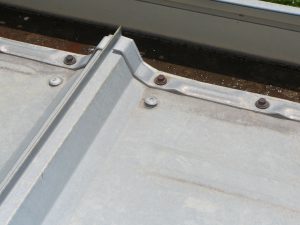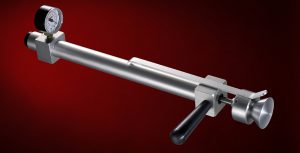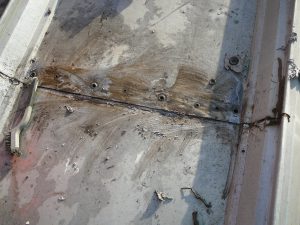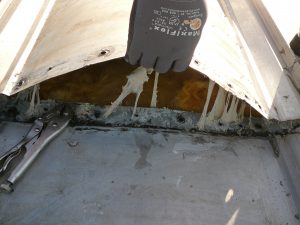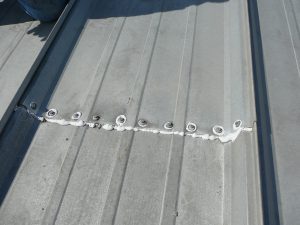Part II of II
by Ray Heisey, P.E., RRC, LEED AP
Metal Roof Inspections Part I of II was published in the December 2017 edition of Proof Points.
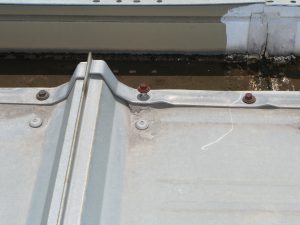 Owners of buildings with low sloped metal roofs struggle with identifying and addressing leaks and other issues. Part I of this article covered many issues that can lead to roof leaks and other concerns on metal roofs. Part II covers additional issues, suggested investigative techniques and several remediation methods to address the defects discovered.
Owners of buildings with low sloped metal roofs struggle with identifying and addressing leaks and other issues. Part I of this article covered many issues that can lead to roof leaks and other concerns on metal roofs. Part II covers additional issues, suggested investigative techniques and several remediation methods to address the defects discovered.
Visual inspection of all exposed fasteners is recommended. Many fastener issues are obvious such as those that are missing, backed out, or not properly seated.
Above: An aluminum rivet fastener that is not seated (tightly sealed) to the roof panel surface.
Below: Backed out screw fastener.
The Wallace SealTester™ Tool is used to verify whether a fastener can hold a vacuum, proving that the fastener seal is air-tight. If numerous fasteners are not seated flat to a metal panel or flashing surface, testing all the suspect fasteners may be time consuming. As an option, few test results can be extrapolated to similar suspect fasteners.
The rubber donut at the base of the tester (pressure gage end) is seated over the fastener head. The round knob handle on the opposite end is pulled until the lever drops into place, keeping the handle extended and maintaining the vacuum. The gage measures the vacuum pressure and any drop in pressure would indicate a potential leak at a fastener. If a fastener has been coated with sealant, the sealant may need to be removed in order for the rubber donut to seal around the flat surface adjacent to the fastener head – allowing for a good test result.
Wallace SealTester™.
A large number of attempted topical sealant or coating repairs is a likely indication the roof has been leaking. Signs such as these are often indicators that the contractor sent to do the repairs never figured out the actual cause of the leak(s).
A topical coating repair trapsmoisture and causes accelerated rusting of the steel roof panels at the end lap joint. Once the coating is completely removed, (depending on the severity of the rusting), the steel should be wire brushed, cleaned, and primed. Severely rusted steel (flaking rust) will require cutting out the severely rusted steel and replacement with new steel sheet metal.
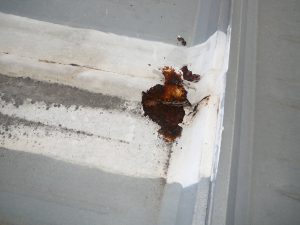
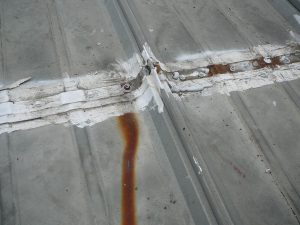
Moisture trapped under the coating caused steel corrosion. Rust staining from steel corrosion under coating.
For an owner, a single layer, liquid applied elastomeric coating is a very inexpensive potential solution to the leak. However, it must be determined whether the coating will correct the actual cause of the leak while not causing any new problems on the metal roof. Most elastomeric coatings are permeable, and if not completely adhered to the substrate, will allow moisture to be trapped. Note: Recoating over previous coatings and sealants is never recommended.
Since individual metal roof panels cannot leak, the sealant joint becomes a critical area for weathertightness. When “chasing leaks” the easiest course of action is to look for panel end laps, curbs, or pipe flashings in the area of the reported leak(s). Unfortunately, repairs are often attempted with whatever coating or sealant has been brought to the site, and will be spread on everything in the general vicinity. This is affecting a temporary repair and treating the symptom, not the actual “disease.” A good analogy is when the head gasket in an automobile engine is leaking; the recommended repair is to replace the gasket, not apply a topical coating. The typical problem on a metal roof is the sealant gasket and the only long-term fix is to replace or repair the gasket. If a metal roof is leaking, the most likely source of leaks is the gasket (butyl sealant) at the panel side lap seam, panel end lap seam, or roof penetration joint.
Repairing the actual cause of a roof leak doesn’t take any more effort than properly applying a liquid coating. Simply remove a few fasteners, clean what can be accessed, apply a high quality polyurethane sealant in the joint such as Vulkem, and install new fasteners. Vulkem, a moisture curing polyurethane sealant, can be successfully used on surfaces that have moisture present during application.
Slotted fastener holes at a roof panel end lap joint.
Depending on the joint, fastener holes should be checked for slotting. If you look at the seven holes in the panel end lap joint (see photo below), you will see that the four original fastener holes are oversized, versus the three more recently added fastener holes. Oversized holes will make it difficult for a fastener to prevent movement between the two pieces of metal being joined together. Oversized (larger diameter) fasteners and large patch washers are a viable solution, as well as adding more fasteners. Large round and square EPDM backed metal washers are available from Dynamic Fastener to fit any fastener diameter.
Disassembly of flashings and end laps is not a very attractive choice because it requires power tools, cleaning, new sealants and new fasteners to properly reassemble the joints. However, many times a simple visual check, wire probe, and fastener check doesn’t provide enough information. If you are recommending a roof replacement or recover on a metal roof, the supporting evidence should be conclusive because a metal roof can last a very long time if installed properly. Standing seam metal roofs exist that have been in the field performing for over 45 years with minimal maintenance. It will be challenging to convince an owner that a recently installed metal roof must be replaced due to poor quality installation or materials.
Poor sealant adhesion to the roof panels in an end lap joint.
The butyl tape sealant adhesion in this end lap joint (see photo to the right) is very poor (minimal observed sealant webbing) and with the dirt in the sealant on the left side, is highly suspect as a source of leaks. Webbing occurs when the sealant has good adhesion to both metal surfaces and, when separated, the sealant looks like a spider web with sealant strings connecting both surfaces along the sealant joint.
The photo below shows a reassembled panel end lap joint. Some of the polyurethane sealant applied in the joint has squeezed out. Polyurethane sealant is UV stabilized (UV resistant), and will not deteriorate when exposed to UV light. Polyurethane sealants will form a protective skin while the underlying sealant remains flexible.
Repaired roof panel end lap joint.
Summary
Depending on the project, sealant, and fastener repairs that address specific issues with penetrations and flashings may delay or avoid a costly roof replacement. In any case, knowledge of the problem(s) is the key to having credibility in recommending repairs or a roof replacement. Addressing widespread issues with panel end laps or roof penetrations on a large roof can be very costly and labor intensive. With contractor repairs, the owner can expect no more than a 2-year warranty, and quite possibly only a 90-day warranty.
If repairs are the best solution, choosing the right contractor will be a key factor in properly completing repairs. When identifying a qualified pool of contractors to bid your project, be sure to select only those firms with experience and expertise in installing low slope metal roof systems. A contractor who is familiar with the materials and installation procedures for a new metal roof can/should also perform the proper repairs on that same existing metal roof. Remember, on a metal roof, prime investigative tools include:
Visual – Look for problem areas such as gaps between roof panels and fasteners not sealed.
Check – Penetrations and flashings for potential issues.
Probe – Use a wire probe (paper clip size) to verify there is contiguous sealant throughout joints.
Test (Wallace SealTester™) – Check fasteners for air leakage.
Investigate – Disassemble joints to check sealant integrity and evidence of water infiltration.
The key to your inspection or investigation is determining whether a waterproofing sealant gasket is in place and functioning properly. Once that is determined, the most cost-effective solution can be recommended, whether it is roof repairs or roof replacement.

